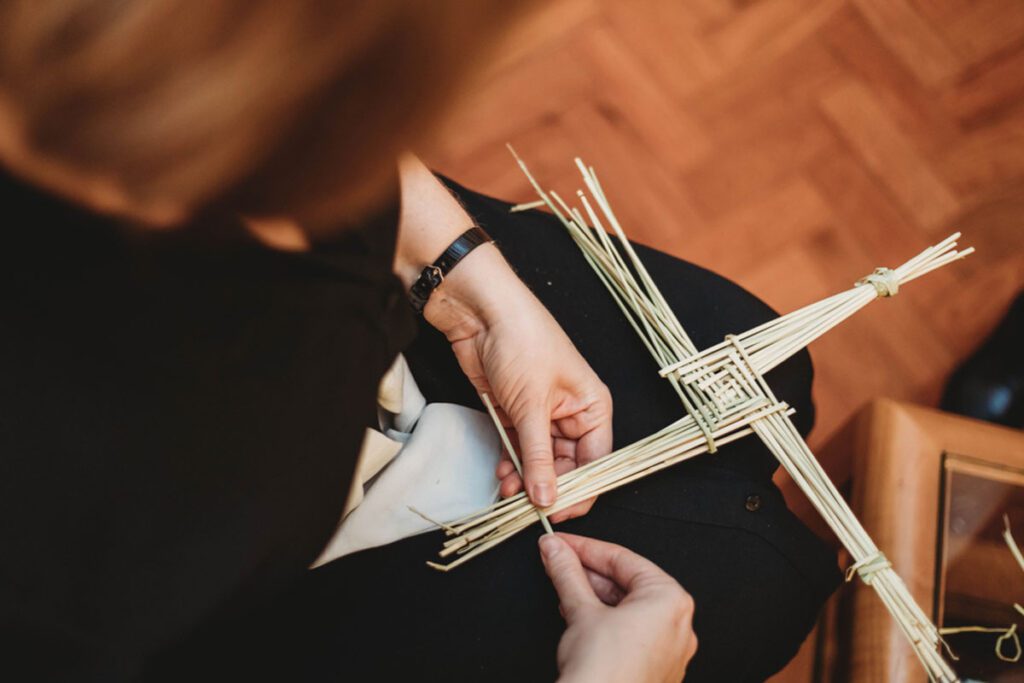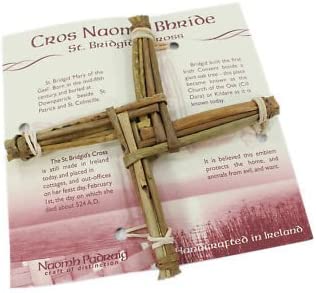
St. Brigid's Cross



In the rich tapestry of Irish folklore and tradition, few symbols hold as much significance as the St. Brigid’s Cross. A potent emblem of protection and faith, this intricate woven cross bears the legacy of Ireland’s beloved patron saint, St. Brigid, and has endured for centuries as a symbol of hope, resilience, and cultural identity.
Origins and Legend
The origins of the St. Brigid’s Cross are steeped in legend, tracing back to Ireland’s early Christian era. St. Brigid herself, often referred to as the “Mary of the Gael,” was a revered figure known for her compassion, healing powers, and unwavering faith. According to tradition, she crafted the first cross from rushes while attending to a dying pagan chieftain. As she wove the rushes together, she used the cross as a tool for instruction, explaining the significance of Christianity and ultimately converting the chieftain before his passing.
Symbolism
The St. Brigid’s Cross embodies a potent blend of Christian and Celtic symbolism, reflecting both the cross of Christ and the ancient pagan reverence for the sun. Its distinctive form, with four arms of equal length extending from a central square or circle, evokes images of the crossroads, where spiritual paths intersect, and the sun, a source of life and renewal.
Each element of the cross carries its own symbolic weight:
- Cross: As a Christian symbol, the cross represents the crucifixion and resurrection of Jesus Christ, embodying themes of sacrifice, redemption, and eternal life.
- Four Arms: The four arms of the cross are often interpreted as representing the four seasons, the four cardinal directions, or the four evangelists (Matthew, Mark, Luke, and John). They also symbolize the unity and interconnectedness of all creation.
- Rushes: Traditionally woven from rushes or straw, the material used to create the cross symbolizes humility, simplicity, and the bounty of the earth.
- Weaving: The intricate weaving process reflects the interconnectedness of life and the importance of community and cooperation in facing life’s challenges.
Cultural Significance
The St. Brigid’s Cross holds a central place in Irish culture, particularly in rural communities where traditions are deeply rooted. It is often hung above doorways and windows to ward off evil spirits, protect the home from harm, and invite the blessings of St. Brigid upon the household.
In addition to its protective qualities, the cross is also associated with rituals of renewal and purification, particularly during the festival of Imbolc, which marks the beginning of spring in the Celtic calendar. During this time, it is customary to make a new St. Brigid’s Cross and display it in the home, symbolizing the transition from darkness to light and the promise of new life.
The enduring popularity of the St. Brigid’s Cross speaks to its timeless appeal and the enduring power of tradition in Irish culture. In an ever-changing world, it serves as a reminder of the enduring values of faith, community, and resilience that have sustained the Irish people through centuries of hardship and triumph. As long as the cross continues to be woven and cherished, the spirit of St. Brigid will live on, watching over and protecting all who seek her blessing.
Embracing Tradition: The Enduring Symbolism of the St. Brigid’s Cross
Expanding further on the significance of the St. Brigid’s Cross illuminates its deep roots in Irish spirituality and folklore. Throughout history, Ireland has faced numerous challenges, from famine and political strife to religious persecution. In times of hardship, the St. Brigid’s Cross has served as a beacon of hope, a tangible expression of faith and resilience in the face of adversity.
The tradition of crafting the cross by hand, often passed down through generations, fosters a sense of continuity and connection to the past. Families gather to weave the crosses together, sharing stories and passing on the techniques and symbolism associated with this cherished ritual. In this way, the St. Brigid’s Cross becomes more than just a symbol; it becomes a link to the past and a promise for the future.
Beyond its cultural significance, the St. Brigid’s Cross also holds a special place in the hearts of the Irish diaspora. As waves of emigration carried Irish traditions to distant shores, the cross became a touchstone for immigrants longing for connection to their homeland. Today, Irish communities around the world continue to celebrate St. Brigid’s Day on February 1st, honoring their heritage and keeping the spirit of St. Brigid alive through rituals, music, and storytelling.
In a rapidly changing world, where technology and globalization often erode traditional customs and beliefs, the enduring presence of the St. Brigid’s Cross serves as a testament to the resilience of Irish culture. It reminds us of the importance of preserving and celebrating our cultural heritage, even as we embrace the innovations and opportunities of the modern age.
Ultimately, the St. Brigid’s Cross transcends its origins as a simple folk tradition, embodying timeless truths and universal values that resonate with people of all backgrounds. Whether displayed in a thatched cottage in rural Ireland or a bustling city apartment halfway around the world, the cross stands as a symbol of faith, hope, and the enduring power of the human spirit.


Evolution and Adaptation
As the St. Brigid’s Cross journeyed through history, it underwent adaptations and variations reflective of the changing times and contexts. While traditionally crafted from rushes or straw, modern interpretations of the cross now incorporate a wide range of materials and techniques, including metal, wood, and even digital renditions. This evolution highlights the cross’s ability to adapt to contemporary expressions of faith and culture while retaining its timeless symbolism.
Global Reverberations
Beyond the shores of Ireland, the St. Brigid’s Cross has garnered admirers and practitioners worldwide, resonating with individuals drawn to its universal themes of protection, renewal, and interconnectedness. From Irish expatriates maintaining ties to their homeland to spiritual seekers embracing its symbolism of faith and resilience, the cross transcends geographical boundaries to touch hearts and minds across the globe.
Revival of Traditional Crafts
In recent years, there has been a renewed interest in traditional Irish crafts and folklore, fueled by a growing appreciation for heritage and authenticity. Artisans and craftsmen are rediscovering the art of weaving St. Brigid’s Crosses, passing on age-old techniques to a new generation eager to connect with their roots. This revival not only preserves a cherished tradition but also fosters a sense of pride and cultural continuity within Irish communities and beyond.
Interfaith Dialogue and Harmony
In an increasingly diverse and interconnected world, the St. Brigid’s Cross serves as a symbol of interfaith dialogue and harmony, bridging divides and fostering understanding among people of different religious and cultural backgrounds. Its fusion of Christian and pagan symbolism offers a powerful reminder of the common threads that unite humanity, transcending religious dogma to celebrate shared values of compassion, unity, and hope.
Looking Ahead
As we gaze toward the future, the St. Brigid’s Cross remains a beacon of light in times of darkness, a testament to the enduring power of faith, tradition, and community. Whether hung above a doorway in a quaint Irish cottage or adorning a mantlepiece in a bustling metropolis, its presence continues to inspire and uplift, reminding us of the timeless truths that bind us together as a global family.
In essence, the St. Brigid’s Cross is not merely a relic of the past but a living symbol of hope and resilience, weaving together the threads of history, tradition, and spirituality to guide us on our journey toward a brighter tomorrow.


